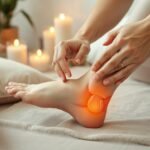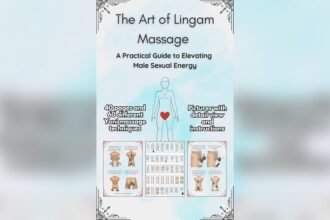Ever thought about making facial scars look better without spending a lot? Facial scar massage is a simple yet powerful method. It can greatly improve how scars look and heal.
Learning to massage facial scars can change lives for those with visible scars. This guide will show you how to do it. You’ll learn techniques to soften, flatten, and reduce itchiness of scars, making your skin more flexible.
Adding scar massage to your skincare routine can boost circulation and healing. It can even help flatten scars over time. Whether your scar is new or old, knowing the right techniques can greatly improve its look and your confidence.
Key Takeaways
- Facial scar massage can improve scar appearance and flexibility
- Regular massage may reduce itchiness and discomfort
- Proper techniques can enhance circulation and promote healing
- Scar massage is a cost-effective alternative to expensive treatments
- Consistency is key for achieving optimal results
Understanding Facial Scars and Their Formation
Facial scars can be tough to deal with. Knowing how they form helps us find ways to reduce them. Let’s dive into the world of facial scars and what makes them.
What are scars?
Scars are how our skin heals after injuries. They happen when we get cuts, burns, or other damage. The healing brings collagen fibers, making the scar tissue strong.
This new tissue is different from our original skin.
How do facial scars develop?
Facial scars come from many things. Common reasons include:
- Cuts from accidents or surgery
- Burns from heat or chemicals
- Acne or skin conditions
- Injuries from falls or impacts
Factors affecting scar formation
Many things affect how scars look and form. These include:
| Factor | Impact on Scar Formation |
|---|---|
| Healing Time | Longer healing times often mean more visible scars |
| Skin Damage Extent | Deeper or bigger wounds usually cause more noticeable scars |
| Age | Younger skin heals quicker but might form larger scars |
| Skin Type | Some skin types are more likely to get keloid or hypertrophic scarring |
Knowing these factors is key when trying to soften scar tissue on the face. It helps improve how scars look overall.
The Importance of Scar Massage for Facial Healing

Scar massage for the face is key in healing facial scars. It offers many benefits for those dealing with scars. Regular massage can make scars look and feel better.
Scar massage softens and flattens scar tissue. It breaks down extra tissue, making scars less noticeable. This leads to smoother scars over time.
Massage also boosts blood flow to the scar area. More blood means more oxygen and nutrients, speeding up healing. This can reduce swelling and pain.
“Consistent scar massage can lead to remarkable improvements in the flexibility and appearance of facial scars.”
Another big plus is that massage keeps skin flexible. It keeps the skin around scars elastic. This is crucial for keeping scars from limiting facial expressions.
| Benefit | Description |
|---|---|
| Softens scar tissue | Breaks down excess scar tissue, reducing thickness |
| Improves circulation | Enhances blood flow, promoting faster healing |
| Increases flexibility | Maintains skin elasticity, preserving facial movements |
| Reduces discomfort | Alleviates pain and sensitivity in the scar area |
Adding scar massage to your care routine is a big step towards healing. Remember, sticking with it is crucial for treating scars.
When to Start Massaging Your Facial Scar
It’s important to know when to start massaging your facial scar. This helps with healing and making the scar less visible. I’ll explain the healing timeline, when you’re ready to start, and why getting professional advice is crucial.
Healing Timeline After Surgery or Injury
The healing time varies for everyone. But usually, you can start facial scar massage 2-3 weeks after surgery or injury. This lets your wound close and heal a bit first.
| Time After Surgery/Injury | Healing Stage | Massage Readiness |
|---|---|---|
| 0-2 weeks | Initial wound closure | Not ready |
| 2-4 weeks | Scab formation and removal | Potentially ready (consult doctor) |
| 4-8 weeks | Scar tissue formation | Usually ready for gentle massage |
Signs Your Scar is Ready for Massage
Check these signs before starting massage:
- Fully closed wound with no open areas
- Absence of scabs or surgical staples
- No signs of infection or inflammation
- Reduced sensitivity in the scar area
Consulting with Your Doctor or Therapist
Always talk to your doctor before starting massage. They can check your situation and give advice on when and how to massage your scar.
Timing and technique are crucial for less visible scars. Your doctor’s advice helps you heal and improve your scar the best way.
Preparing for Facial Scar Massage

I know how important facial scar management is, and I’m here to guide you through the preparation process. Before you start learning how to massage a scar on face, it’s crucial to set up properly. This ensures the best results and keeps your skin safe.
First, I always make sure my hands are squeaky clean. This step is vital for preventing any unwanted bacteria from getting near the scar. Next, I grab a water-based cream. These are great for reducing facial scarring and providing the right amount of slip for the massage.
I prefer using a mirror when I massage my facial scar. It helps me see what I’m doing and track my progress over time. Good lighting is key too. I set up in a spot where I can clearly see my face and the scar I’m working on.
- Clean hands thoroughly
- Apply water-based cream
- Set up a mirror and good lighting
- Find a comfortable position
Comfort is crucial for effective facial scar management. I make sure I’m in a relaxed position before starting. If my scar is still tender, I begin with very light pressure. As I get more comfortable, I gradually increase the pressure to what feels right for me.
By following these preparation steps, I’m ready to begin massaging my facial scar effectively and safely. This careful approach sets the stage for successful scar treatment and improved skin appearance.
How to Massage a Scar on Face: Step-by-Step Guide
Learning facial scar massage techniques is key to bettering scar looks. I’ll show you how to use scar tissue massage methods for the best outcomes.
Choosing the Right Massage Technique
Use your finger pads for facial scar massage. Move them in different ways: side to side, up and down, and in circles. This variety breaks down scar tissue and boosts skin flexibility.
Applying Appropriate Pressure
Begin with light pressure and then increase it. You want to move the scar and skin, not just rub over it. You’ll know you’re applying enough pressure when the skin turns white under your fingers.
Massage Duration and Frequency
For the best results, massage each scar area in slow circles for about four minutes. Try to massage daily, ideally several times a day. Each session should last at least 10 minutes.
| Massage Aspect | Recommendation |
|---|---|
| Technique | Circular, side-to-side, up-and-down motions |
| Pressure | Light to firm, causing skin to blanch |
| Duration per area | 4 minutes |
| Total session time | Minimum 10 minutes |
| Frequency | Daily, multiple times if possible |
| Treatment period | 3-6 months post-surgery or injury |
Stick to these scar tissue massage methods regularly. You’ll see your scar’s appearance improve and your skin become more flexible.
Essential Products for Facial Scar Massage

Choosing the right products is key when treating facial scars. The right items can greatly help in softening scar tissue and improving scar massage results.
Water-based creams or lotions are great for facial scar massage. They help prevent friction during the massage. Some good options include:
- Aqueous cream
- E45 hand cream
- Gentle, fragrance-free moisturizers like Eucerin or Cocoa Butter
Vitamin E oil is also beneficial for scar massage. It can improve skin elasticity and reduce scar appearance. It’s important to pick products without perfumes or harsh ingredients to avoid irritation.
| Product Type | Benefits | Precautions |
|---|---|---|
| Water-based creams | Lubrication, friction reduction | Choose fragrance-free options |
| Vitamin E oil | Skin elasticity improvement | Patch test for allergies |
| Gentle moisturizers | Hydration, scar softening | Avoid harsh ingredients |
Always choose products safe for sensitive skin when treating facial scars. This helps avoid irritation or allergic reactions. Using these products consistently in your scar massage routine can lead to better results.
Benefits of Regular Facial Scar Massage
Regular facial scar massage can greatly reduce facial scarring and improve how scars look. I’ve seen that regular massage has many benefits. It helps make scars less noticeable and improves skin health.
Improving Scar Appearance
Facial scar massage softens and flattens scar tissue. It breaks down extra tissue, making the scar area smoother. This can make the scar less noticeable over time.
Enhancing Skin Flexibility
Massage boosts collagen production and makes skin more elastic. This makes the scar area move better with facial expressions. It also reduces tension and stops more tissue from building up.
Reducing Discomfort and Sensitivity
Regular massage can make scars less painful and itchy. It makes the scar area less sensitive to touch. This makes life better for people with facial scars.
| Benefit | Impact on Scar | Long-term Result |
|---|---|---|
| Improved Appearance | Softens and flattens tissue | Less visible scar |
| Enhanced Flexibility | Increases skin elasticity | More natural movement |
| Reduced Sensitivity | Decreases discomfort | Improved comfort and confidence |
Adding facial scar massage to your skincare routine is a smart move. It helps reduce scar visibility and promotes healthier skin. Remember, being consistent is crucial for lasting improvements in scar appearance and skin health.
Precautions and Potential Risks
When treating facial scars, it’s crucial to be aware of potential risks. Facial scar management requires caution and careful attention. This ensures the best results. Here are some key precautions to keep in mind when massaging a scar on your face:
- Wait for full healing: Don’t start massaging until your wound has completely healed.
- Watch for infection: Stop massaging if you notice redness, swelling, or discharge.
- Be gentle: Use light pressure, especially near sensitive areas like eyes or mouth.
- Avoid overstretching: Too much pressure can damage the skin and worsen scarring.
- Protect from sun: Scars are more prone to sunburn, so use sunscreen or cover up.
If you experience pain, blistering, or a rash while massaging your scar, stop immediately. It’s always best to consult with a healthcare provider before starting any new scar treatment routine. They can guide you on the safest and most effective methods for your specific case.
| Warning Sign | Action to Take |
|---|---|
| Pain during massage | Stop and consult doctor |
| Redness or swelling | Pause massage, monitor for improvement |
| Open areas or blistering | Seek medical attention immediately |
| Increased sensitivity | Reduce pressure or frequency of massage |
Remember, effective facial scar management is a gradual process. By being mindful of these precautions, you can safely work towards improving the appearance of your facial scars through massage and other treatments.
Combining Scar Massage with Other Treatments
Managing facial scars is more than just massage. A mix of treatments works best. Let’s look at some that can help improve your scar’s look.
Moisturizing and hydration
It’s important to keep your scar moisturized. I use a gentle, fragrance-free moisturizer all day. This keeps the skin soft and helps massage work better.
Sun protection for scars
UV rays can make scars worse. So, protecting your scar from the sun is key. I always wear a broad-spectrum sunscreen with at least SPF 30. It helps keep the scar safe and aids in healing.
Professional treatments to consider
For scars that don’t get better, professional help can make a big difference. Options like silicone sheets, laser therapy, and microneedling are worth talking to a dermatologist about. These can enhance the effects of massage. Always check with a healthcare expert before trying new treatments for your scars.
FAQ
When should I start massaging my facial scar?
What products should I use for facial scar massage?
How do I properly massage a facial scar?
How often should I massage my facial scar?
What are the benefits of regular facial scar massage?
Are there any precautions I should take when massaging a facial scar?
Can scar massage be combined with other treatments?
Source Links
- PDF – https://www.stgeorges.nhs.uk/wp-content/uploads/2021/09/Scar-scar-massage.pdf
- Massaging a Scar After Mohs Surgery: When Can You Do It? | Dermatology and Skin Health – Dr. Mendese – https://dermskinhealth.com/massaging-a-scar-after-mohs-surgery/
- Scar Massage—How to Promote Healing – https://www.kidney.org/scar-massage-how-to-promote-healing













7 Comments
Ever considered that massaging facial scars might actually trigger memories of the trauma that caused them?
Interesting read, but doesnt massaging a facial scar risk increasing inflammation? Need expert opinion on this.
Does massaging really help in scar reduction? Or is it just a myth propagated by skincare companies?
Interesting guide, but does massaging really speed up the healing process of facial scars, or just improve their appearance?
Interesting read! But does massaging really reduce scar appearance or is it just a placebo effect? Any scientific evidence to back this up?
Ever heard of collagen remodeling? Do some research before doubting. Touch therapy does wonders!
Interesting guide! But wont massaging facial scars potentially stretch them or make them more noticeable? Thoughts?